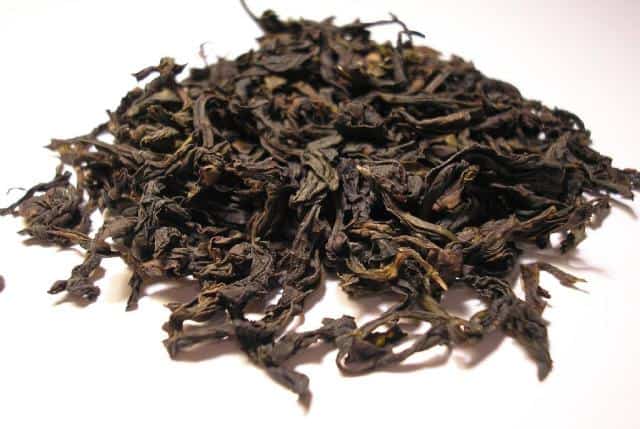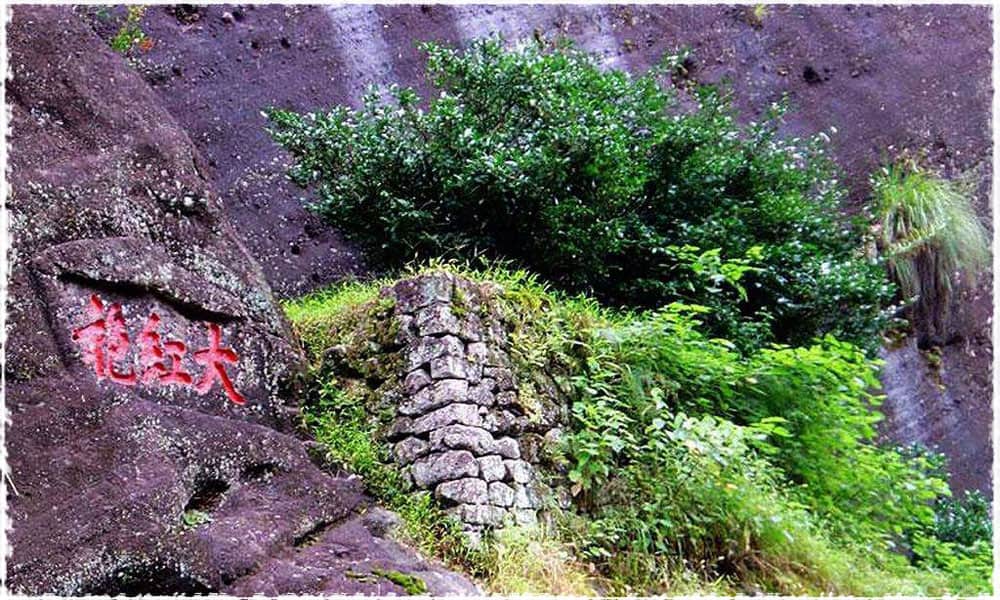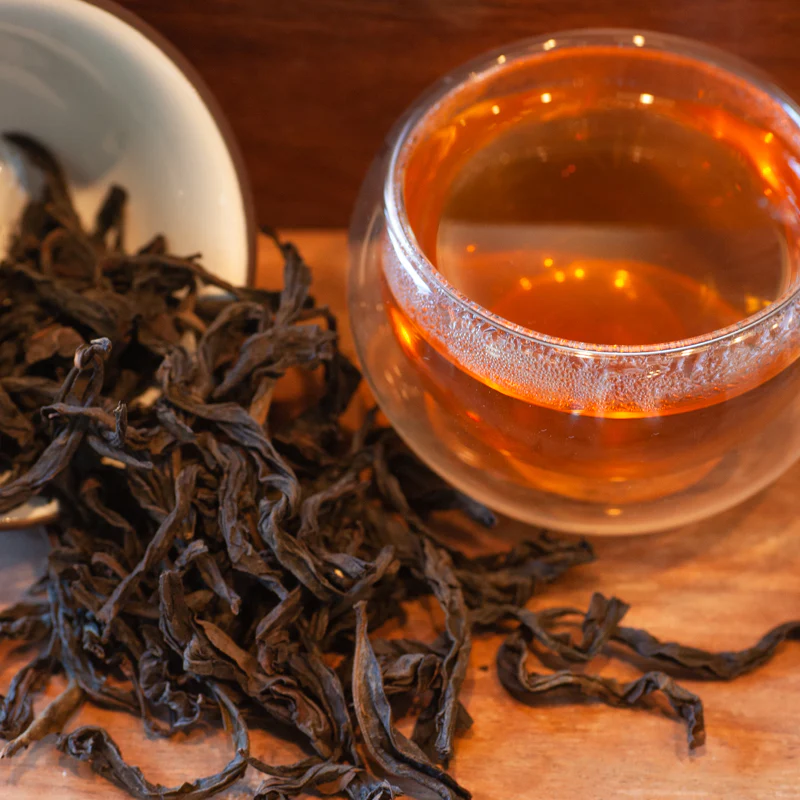Da Hong Pao (Big Red Robe): The Story of China’s Most Famous Oolong Tea
Da Hong Pao, also known as Big Red Robe, is one of the most famous oolong teas in China. It originated from the Wuyi Mountains of Fujian province and is renowned for its complex, rich flavor and aroma. In this blog post, we will dive into the history, legend, and production process of Da Hong Pao tea.
The Legend of Da Hong Pao Tea
According to legend, Da Hong Pao tea was discovered during the Ming Dynasty when a scholar was cured of an illness after drinking the tea. As a token of his gratitude, he gave red robes to the tea bushes from which the tea was produced.
These tea bushes are still growing in the Wuyi Mountains today, and their leaves are considered priceless.
History of Da Hong Pao Tea
The production of Da Hong Pao tea has a long history that dates back to the Tang Dynasty. The tea gained popularity during the Ming Dynasty, and its fame only grew from there. During the Qing Dynasty, Da Hong Pao tea was declared an imperial tribute tea, reserved only for the emperor’s consumption.
Production Process of Da Hong Pao Tea
The production of Da Hong Pao tea is a highly skilled process that involves several steps. The tea leaves are picked and then withered in the sun for a few hours. After the withering process, the leaves are placed in bamboo baskets and shaken to bruise the edges of the leaves.
This process is called “kill-green” and helps to start the oxidation process. The leaves are then spread out to dry before being roasted over charcoal. The roasting process is what gives Da Hong Pao its unique, smoky flavor. Here is an overview of the traditional production process:
- Cultivation and Harvesting:
- Da Hong Pao tea is typically harvested from ancient tea bushes in the Wuyi Mountains of Fujian Province, China. The tea plants are allowed to grow naturally in the rocky terrain, contributing to the unique flavor profile.
- Withering:
- After harvesting, the tea leaves undergo withering to reduce moisture content. This is often done outdoors or in well-ventilated indoor spaces, allowing the leaves to wilt and become more pliable.
- Manual Rolling:
- The withered leaves are hand-rolled to break down the cell structure and initiate oxidation. This step contributes to the development of the tea’s flavor and aroma.
- Oxidation:
- Unlike green teas, Da Hong Pao is partially oxidized. The degree of oxidation can vary, but it is generally between 20% and 40%. This step is crucial in determining the tea’s ultimate characteristics.
- Roasting (Kill-Green):
- The oxidized leaves are subjected to roasting in large woks or rotating drums. This process halts further oxidation and imparts a distinct roasted flavor to the tea. Skilled artisans monitor the roasting carefully to achieve the desired level of char and aroma.
- Shaping:
- The roasted leaves are shaped into the traditional long, twisted strips characteristic of Da Hong Pao. This step enhances the tea’s appearance and prepares it for the final firing.
- Final Roasting:
- The shaped tea leaves undergo a final roasting to refine the flavor and remove any remaining moisture. This step is crucial in achieving the balance between the roasted, mineral, and floral notes that define Da Hong Pao.
- Sorting and Grading:
- After the final roasting, the tea leaves are sorted based on size, appearance, and quality. Higher-grade leaves are often set aside for premium Da Hong Pao, while smaller leaves may be used in lower-grade varieties.
- Packaging:
- The sorted tea leaves are packaged in airtight containers or vacuum-sealed bags to preserve their freshness and flavor. Premium Da Hong Pao is often packaged in smaller quantities to maintain its exclusivity.
Tasting Notes of Da Hong Pao Tea
Da Hong Pao tea has a complex, layered flavor that is difficult to describe. It has a rich, smoky aroma and a deep, earthy taste with notes of caramel and honey. The tea is full-bodied and has a long, lingering finish. Because of its complex flavor profile, Da Hong Pao tea is often compared to a fine wine.
| Aspect | Tasting Notes |
|---|---|
| Appearance | Dark, twisted, and large tea leaves with a roasted appearance. |
| Aroma | Rich, complex, and deep roasted aroma with hints of char, mineral, and a touch of floral sweetness. |
| Flavor | Robust and full-bodied with prominent roasted and mineral notes. Subtle sweetness emerges with a hint of cocoa and a long-lasting aftertaste. |
| Liquor Color | Deep amber or reddish-brown, often clear and bright. |
| Mouthfeel | Smooth and velvety texture with a slight dryness. Well-balanced and lingering on the palate. |
| Undertones | Charcoal, dark chocolate, roasted nuts, and a distant floral or orchid-like sweetness. |
| Astringency | Low to medium, providing structure without overpowering bitterness. |
| Finish | Lingering, with a pleasant aftertaste that evolves from roasted to sweet. |
| Overall Impression | A bold and complex oolong with a captivating interplay of roasted, mineral, and sweet notes. A tea that unfolds its layers with each infusion. |
Health Benefits of Da Hong Pao Tea
Like other oolong teas, Da Hong Pao tea is packed with health benefits. It is rich in antioxidants, which help to reduce the risk of chronic diseases like cancer and heart disease. The tea is also believed to aid in digestion, boost metabolism, and improve mental alertness.
How to Brew Da Hong Pao Tea
Da Hong Pao, also known as Big Red Robe, is a highly prized oolong tea from the Wuyi Mountains in China. Here’s how to brew Da Hong Pao:
- Use high-quality water. Da Hong Pao is a delicate tea that is easily affected by the quality of water. Use filtered or spring water that is not too hard or too soft.
- Preheat your teapot and cups. Pour some hot water into the teapot and cups to preheat them, then discard the water.
- Measure out your tea. For every 6 ounces (180 ml) of water, use 1-2 teaspoons (2-4 grams) of Da Hong Pao tea leaves.
- Brew the tea. Place the tea leaves into the teapot and pour hot water over them. The water should be heated to a temperature of around 195-205°F (90-96°C). Let the tea steep for 1-2 minutes.
- Pour and serve. After steeping, pour the tea into cups and enjoy. Da Hong Pao can be brewed multiple times, so you can add more hot water to the teapot and steep the leaves again.
When brewing Da Hong Pao, it’s important to use high-quality tea leaves and not over-brew the tea to avoid bitterness. The water temperature should also be carefully controlled to bring out the tea’s full flavor and aroma. By following these steps, you can brew a delicious and authentic cup of Da Hong Pao tea.
Price of Da Hong Pao (Big Red Robe)
The price of Da Hong Pao (Big Red Robe) can vary greatly depending on several factors, such as the quality of the tea leaves, the region where it was grown, and the rarity of the tea.
Some of the finest and most authentic Da Hong Pao can fetch prices upwards of thousands of dollars per pound, making it one of the most expensive teas in the world. This is due to its limited production, as only a small amount of authentic Da Hong Pao is produced each year.
However, there are also more affordable options available for those who want to try Da Hong Pao without breaking the bank. Lower-quality Da Hong Pao can be found at more reasonable prices, usually ranging from $20 to $100 per pound.
It’s important to note that there are many counterfeit versions of Da Hong Pao on the market, often sold at lower prices. These teas are not genuine and are often made from lower-quality tea leaves. It’s recommended to purchase Da Hong Pao from a reputable source to ensure its authenticity and quality.
Conclusion
Da Hong Pao tea is a legendary tea that has a rich history and complex flavor profile. Its smoky, earthy taste and long finish make it a favorite among tea enthusiasts. And with its numerous health benefits, it’s not surprising that it has remained popular for centuries.
So the next time you’re looking for a unique and flavorful tea to try, consider picking up a bag of Da Hong Pao and experiencing the legend for yourself.
Originally posted 2023-04-01 12:47:30.




